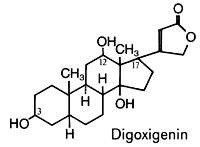
Figure 1. Structure of digoxigenin.
An epitope is a portion of a molecule to which an antibody binds. Epitopes can be composed of sugars, lipids or amino acids. In most cases, epitope tags are constructed of amino acids. Epitope tags are added to a molecule (usually proteins) which an investigator wants to visualize. Visualization can take place in a gel, a western blot or labeling via immunofluorescence.
If you wanted to follow a particular protein but did not have an antibody that would bind your protein, you might consider adding an epitope tag onto your protein. Epitope tags range from 10 to 15 amino acids long and are designed to create a molecular handle for your protein. An epitope tag could be placed anywhere within your protein, but typically they are placed on either the amino or carboxyl terminus to minimize any potential disruption in teriary structure and thus function of your protein.
Although any short stretch of amino acids known to bind an antibody could become an epitope tag, there are a few that are especially popular. Three examples include:
c-myc - a 10 amino acid segment of the human protooncogene myc (EQKLISEEDL)
HA - haemoglutinin protein from human influenza hemagglutinin protein (YPYDVPDYA)
His6 - If six histidines are placed in a row, they form a structure that binds the element Nickle. This is especially useful for affinity chromostography but can also be used as an epitope tag.
GFP - green flourescent protein has become the one of the most popular reporter proteins and as such a nice epitope tag. However, GFP is much larger than most other epitope tags.

Figure 1. Structure of digoxigenin.
DIG - digoxigenin is a small organic molecule rather than amino acids (figure 1). DIG can be covalently added to proteins or nucleic acids which makes it very handy in its diverse applications.
biotin - the other half of the molecular velcro of avidin, biotin is a small molecule that can be covalently linked to proteins after they have been translated. Therefore, unlike most other prortein epitope tags, it can be added at any point in time and is often used to label proteins located in particular sites such as on the extracellular surface of cells.
flourescent dyes (e.g. FITC, Cy3, Cy5, etc.) - since antibodies that bind to any antigen, epitope tags can be generated from any molecule. Investigators have taken full advantage of this and used fluorecent dyes as eiptope tags.
© Copyright 2002 Department of Biology, Davidson College, Davidson, NC 28036
Send comments, questions, and suggestions to: macampbell@davidson.edu